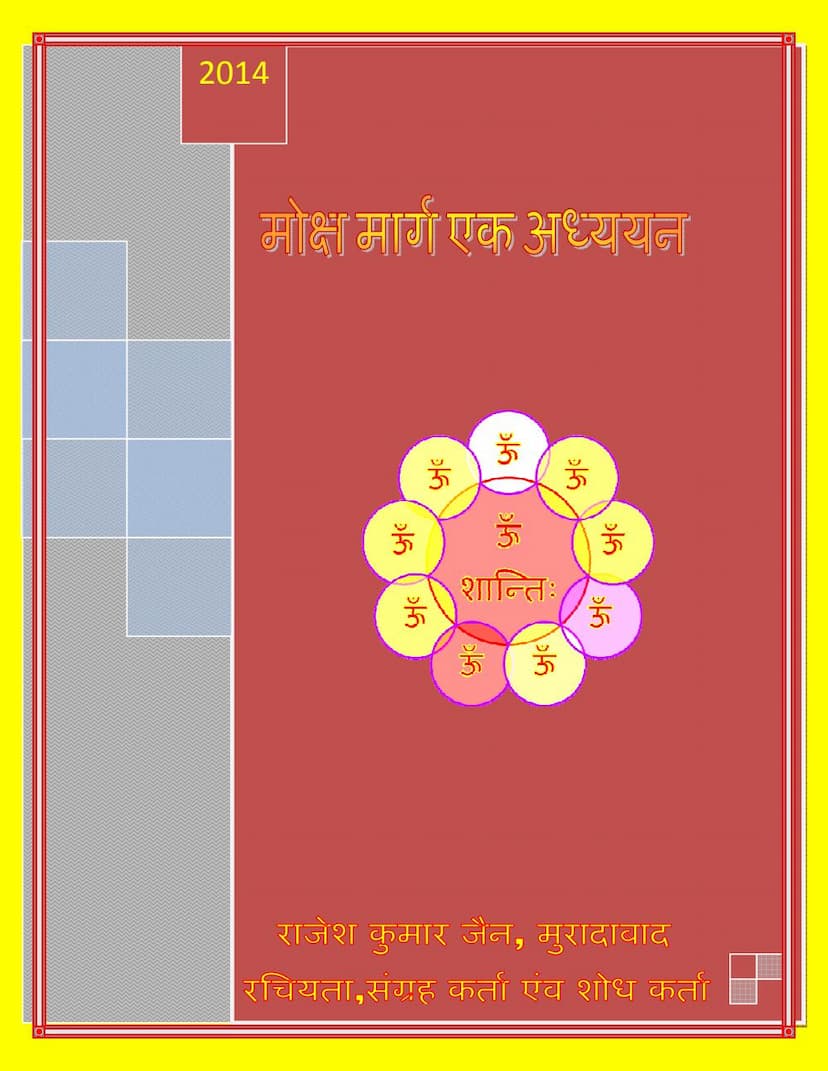Mokshmarg Ek Adhyayan
Added to library: September 2, 2025

Summary
This document is a comprehensive summary of the Jain text "Moksh Marg Ek Adhyayan" (A Study of the Path to Liberation) by Rajesh Kumar Jain. The book aims to guide readers on the path to spiritual liberation within Jainism.
Here's a breakdown of the key aspects covered in the text:
Author and Inspiration:
- The book was written by Rajesh Kumar Jain from Moradabad, UP, India.
- The inspiration came from his mother, Smt. Prem Lata Jain, who encouraged him to share his knowledge of Samyagjnana (right knowledge).
- The author expresses gratitude to his family and acknowledges potential shortcomings due to his limited intellect, inviting feedback for improvement.
Core Components of Moksha Marg (Path to Liberation): The book is structured around "11 Pearls" or key spiritual concepts, along with other essential Jain teachings:
- Mangalacharan (Invocation): Begins with auspicious invocations to the Jinavani (the divine word of the Jinas), Jain Gurus, and Lord Mahavir, seeking blessings for the undertaking.
- Anuvarata (Small Vows): Detailed explanation of the five Anuvaratas: Ahimsa (non-violence), Satya (truthfulness), Achaurya (non-stealing), Brahmacharya (celibacy/chastity), and Aparigraha (non-possession).
- Dash Lakshan Dharma (Ten Virtues): Elaboration on the ten cardinal virtues: Kshama (forgiveness), Mardav (humility), Arjava (honesty), Satya (truthfulness), Shaucha (purity), Samyama (restraint), Tapa (austerity), Tyaga (renunciation), Akinchana (non-attachment), and Brahmacharya (chastity).
- Samyagdarshan (Right Faith): Explains Samyagdarshan as being free from 25 defects and possessing 8 virtues, with a detailed discussion on Mad (pride), Dosh (defects), Mooldhata (delusions) like Lok Mooldhata, Dev Mooldhata, and Guru Mooldhata, and Anayatan (unsuitable places/objects of worship). It also covers the 8 Angas (limbs) of Samyagdarshan: Nishankit, Nikankshit, Nirvichikitsa, Amudradrishti, Upaguhan, Sthitikaran, Vatsalya, and Prabhavana.
- Samyagjnana (Right Knowledge): Describes the four types of Jain knowledge: Mati (sense perception), Shruta (scriptural), Avadhi (clairvoyant), Manahparyaya (mind-reading), and Keval (omniscience). It further categorizes knowledge into four Anuyogas: Prathamanuyoga, Karunanuyoga, CharanAnuyoga, and Dravyanuyoga, and discusses Nayas (viewpoints).
- Samyakcharitra (Right Conduct): Explains Charitra (conduct) as the path to overcoming the five sins. It distinguishes between Sakal Charitra (complete conduct of monks) and Vikal Charitra (partial conduct of laypeople). Sakal Charitra involves five Mahavratas (great vows), three Guptis (restraints), and five Samitis (carefulness). Vikal Charitra comprises the five Anuvaratas, three Gunavratas (virtue vows), and four Shikshavratas (disciplinary vows). It also touches upon the 22 types of Parishah (hardships) endured by ascetics and the two types of Tapa (austerity): Bahya Tapa (external austerity) and Antaranga Tapa (internal austerity).
- 16 Bhavanas (Meditations/Reflections): Details the sixteen principles or meditations that lead to spiritual progress, including Darshan Vishuddhi, Vinay Sampannata, Sheelavratanvantichara, Abhikshna Jnanopayog, Samvega, Shaktist Tyaga, Shaktist Tapa, Sadhu Samadhi, Vaiyavruttyakaran, Arhad Bhakti, Acharya Bhakti, Bahushrut Bhakti, Pravachan Bhakti, Avashyakaparipani, Marga Prabhavana, and Pravachan Vatsalya.
- Samadhimarana (Peaceful Death): Discusses the ideal death achieved through spiritual practice, emphasizing the importance of renouncing attachments and seeking forgiveness.
- Jinavani Ki Stuti (Praise of the Jinavani): A poetic invocation praising the divine speech of the Tirthankaras.
- 11 Pratimas (Stages of Lay Observance): Outlines eleven stages of spiritual progress for lay practitioners, ranging from Darshan Pratima to Uddesh Virati Pratima.
- Shravaka Pratikraman (Confession of Laypeople): A prayer for repentance of sins committed, seeking purification and liberation.
Author's Personal Journey and Beliefs:
- Rajesh Kumar Jain shares his personal journey, including his upbringing with religious influences from both his Shvetambar Sthanakvasi (paternal grandfather) and Digambar Jain (paternal grandmother) sides.
- He describes his decision to prioritize spiritual study over pursuing formal degrees despite multiple opportunities.
- He highlights significant spiritual experiences, including receiving Anuvrat teachings, performing Siddha Chakra puja, and experiencing a spiritual calling.
- He clarifies that while he appears worldly, he adheres to Brahmacharya and Sheel (virtue).
- He expresses his belief that while the current era (Pancham Kal) might not allow for Shukla Dhyana (pure meditation) and Moksha in the Bharata and Airavata regions, it is possible in other regions like Videha Kshetra.
- He asserts that venerating figures like Brahma, Vishnu, Mahesh, Buddha, and Goddess Saraswati is not necessarily Mithyatva (false belief) within the Jain context if done with respect for their roles in spiritual propagation or association with Jain principles.
Structure and Content: The book is structured logically, guiding the reader through foundational Jain concepts to advanced spiritual practices. It includes:
- Author's Note: Explaining the genesis and basis of the book.
- Greetings/Endorsements: From his mother, mother-in-law, and wife, offering positive feedback and encouragement.
- Financial Support: Information for donors to support the free distribution of the book.
- Suvichar (Good Thoughts): Philosophical musings on education and self-realization.
- Jivan Parichay (Biography): A detailed account of the author's life, education, family, and spiritual journey.
- Detailed Explanations: Of all the key Jain concepts mentioned above, often quoting from or referencing important Jain scriptures like Samaysar, Tattvartha Sutra, and Ratnakarand Shravakachar.
- Mantras and Jap: Inclusion of mantras and prayers for various deities and virtues.
- Aarti: A devotional song dedicated to Lord Mahavir.
- Lists: Such as the names and symbols of the 24 Tirthankaras.
Overall Purpose: "Moksh Marg Ek Adhyayan" serves as a guide for Jains and anyone interested in understanding the path to spiritual liberation according to Jain philosophy. It emphasizes the integration of knowledge, meditation, and austerity as the core elements for achieving Moksha. The author's aim is to make this profound knowledge accessible to all.